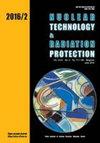不同粒径PbO掺入对聚苯乙烯x射线衰减的影响
IF 0.7
4区 工程技术
Q3 NUCLEAR SCIENCE & TECHNOLOGY
引用次数: 3
摘要
采用辊磨混合和压缩成型技术,将两种不同尺寸(A = 78 nm和B = 54 nm)的氧化铅(PbO)体和纳米颗粒分别以不同浓度(0%、10%、15%、25%和35%)掺入聚苯乙烯基体中。利用x射线窄谱系列(n -系列/ ISO 4037-1)研究了新型聚合物复合材料PS/PbO的辐射衰减能力,以及不同PbO粒径对屏蔽性能的影响。利用扫描电镜和能量色散x射线能谱对合成的复合材料进行了填料弥散和化学元素分析。为了确定质量衰减系数?m,利用x射线能量范围检测了不同厚度的合成复合材料样品,并将实验数据与NIST数据库(XCOM和FFAST)的理论值进行了比较。结果表明,无论是增加填料的重量百分比,还是减小填料的粒径,都能增强各能量的衰减参数。含PbO纳米尺寸最小的复合材料在所有组合中表现出最大的辐射屏蔽效果,因此可用于开发低成本、轻量化的x射线屏蔽材料。本文章由计算机程序翻译,如有差异,请以英文原文为准。
Effect of PbO incorporation with different particle size on X-ray attenuation of polystyrene
Lead oxide (PbO) bulk and nanoparticles of two different sizes (A = 78 nm and B = 54 nm) are incorporated separately into the polystyrene matrix at various concentrations (0, 10, 15, 25, and 35 %) using roll mill mixing and compressing molding techniques. The X-ray narrow-spectrum series (N-series / ISO 4037-1) is then used to investigate the radiation attenuation capability of the novel polymer composite PS/PbO, as well as the effect of varying PbO particle sizes on shielding performance. The filler dispersion and chemical elemental analysis of the synthesized composite are investigated using scanning electron microscopy and energy-dispersive X-ray spectroscopy. To determine the mass attenuation coefficients ?m, samples with various thicknesses of the synthesized composite are examined using a range of X-ray energies, and the experimental data are compared to theoretical values from NIST databases (XCOM and FFAST). The results indicate that either increasing the filler weight percentage or, decreasing the filler particle size, enhanced the attenuation parameters throughout all energies. The composite containing the smallest nanosize of PbO exhibited the maximum radiation shielding efficacy among all combinations and therefore, might be used to develop low-cost and lightweight X-ray shields.
求助全文
通过发布文献求助,成功后即可免费获取论文全文。
去求助
来源期刊

Nuclear Technology & Radiation Protection
NUCLEAR SCIENCE & TECHNOLOGY-
CiteScore
2.00
自引率
41.70%
发文量
10
审稿时长
6-12 weeks
期刊介绍:
Nuclear Technology & Radiation Protection is an international scientific journal covering the wide range of disciplines involved in nuclear science and technology as well as in the field of radiation protection. The journal is open for scientific papers, short papers, review articles, and technical papers dealing with nuclear power, research reactors, accelerators, nuclear materials, waste management, radiation measurements, and environmental problems. However, basic reactor physics and design, particle and radiation transport theory, and development of numerical methods and codes will also be important aspects of the editorial policy.
 求助内容:
求助内容: 应助结果提醒方式:
应助结果提醒方式:


